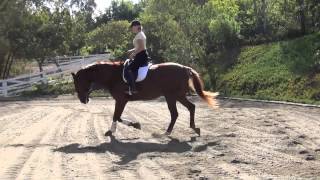Tag: development
Zoolander Canter
11th October
Good morning this is Will Faerber from Art2Ride and today we are giving you an update on Zoolander. Zoolander is our rescue horse that had been given to us because his owner was convinced that he was dangerous. What we discovered was that the horse was basically running away from pain: his saddle was killing him, his back was killing him and his feet were in terrible shape. That is the biggest thing that we have had to deal with for the last three months that we have had him is just getting his feet to the point where he is sound enough and comfortable enough on his feet to be able to be worked. You can find a video about our horseshoer Kenny Lyon and getting Zoolander straightened out in our videos.
Today we are going to show you where …
Do I need to have my horse’s hocks, back and neck injected?
“The last barn I was at insisted that I routinely have my horse’s hocks injected. Is that part of your “maintenance” routine?”
No; horses that are trained and developed correctly don’t usually need them. I totally agree with the studies that have found the best cure is a preventative one. A person’s money can be more wisely spent by finding a trainer that can progress a horse properly so the need of injections doesn’t arise instead of trying every new cure on the market to “patch” a horse up.
I’m certainly not saying that there aren’t cases where some intervention may be necessary but we rarely have them ourselves. We’ve had horses brought to us that were deemed lame and were only usable because of their routine injections but are now drug free and sound. We are not trying to replace the …
Do you personally train my horse or just use other trainers?
We get told this all the time by new clients who talk about their past trainer experiences: “I was shocked and disappointed before to find out that my horse (who is supposed to be in full time training) is being ridden by someone other than the trainer, or being lunged by grooms or simply turned out, is that the usual practice?“.
Not with us and never will be. Every time a horse is being handled by a person it is learning and developing habits that are correct or incorrect. It is either being handled in a way that aids its development or deters from it. It makes no sense to us to allow any kind of handling that is a contradiction to a horse’s progress, for example lunging a horse with a halter that allows it to use the opposite set …
Other trainers have me sit the trot but you don’t seem to, why is that?
Another vicious cycle. In a perfect world a rider would learn to ride on a schoolmaster that has been developed CORRECTLY which to us would mean it has a great topline and is capable of keeping his back “up” so then the rider could spend a lot of time developing the skill for the sitting trot on a horse that will “allow” them to sit correctly and relatively effortlessly. Unfortunately this is not a perfect world and most riders begin on horses that aren’t developed yet or developed incorrectly. This combination is certainly not insurmountable if done logically. This process should be symbiotic for the horse and rider.
If an inexperienced rider sits the trot on a horse that is hollow to begin with it is uncomfortable and near impossible to stay relaxed (for horse and rider) The unavoidable progression is …
Why do you begin piaffe so early?
In the beginning it is a gymnastic tool and done in hand. We are not trying to achieve an immediate correct piaffe but it is one of the best gymnastic exercises to teach the horse to bend the joints in the hindlegs, begin to carry more weight on the hindlegs and to engage the back and stomach muscles. The same thing one is asking for when we ask the horse to collect (albeit to a lesser degree). It is easier for a horse to start developing these abilities in-hand without the weight of the rider and begin the correct muscle development that makes collection easier. So it makes sense to us that a horse start to develop these abilities, muscling and the understanding of the aids that indicate that we would like more engagement, before we start to ask the …





